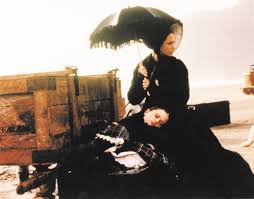
emily dickinson as fashion icon
or holly hunter in the piano
and her maddening braids

or
holly's boots
and feel quite like angels and insects
today
have a fond memory of kristin scott thomas's wrist as it flicked over her insect sudy in the rainforest
obviously stuck in 1995
overall the film was nauseating.
cannot find a still or a youtube of the scene.
so goes the nineties into obscurity . . .
dandyism.net is quite a delight . . .
this cultural phemomen pervades my thinking at times, endemic to both my parent's way.
it is so unobtrusive, so unliberace leo. so calm and jil sander stoic.
read on:
but what i also want to describe is the swedish virtue of lagom, not too much.
wiki:
The Lexin Swedish-English dictionary defines lagom as "enough, sufficient, adequate, just right". Lagom is also widely translated as "in moderation", "in balance", "optimal", "suitable", and "average". But whereas words like "sufficient" and "average" suggest some degree of abstinence, scarcity, or failure, lagom carries the connotation appropriateness although not necessarily perfection. The archetypical Swedish proverb "Lagom är bäst", literally "Lagom is best", is translated as "Enough is as good as a feast" in the Lexin dictionary. That same proverb is translated as "There is virtue in moderation" in Prismas Stora Engelska Ordbok (1995).
and related concept
The Jante Law (Danish and Norwegian: Janteloven; Swedish: Jantelagen; Finnish: Janten laki; Faroese: Jantulógin) refers to a pattern of group behaviour towards individuals within Scandinavian communities, which negatively portrays and criticizes success and achievement as unworthy and inappropriate.
It has been observed as a form of behaviour for centuries, but the Norwegian/Danish author Aksel Sandemose identified it as a series of rules, the Jante Law, in his novel A fugitive crosses his tracks (En flyktning krysser sitt spor, 1933, English translation published in the USA in 1936). Sandemose's novel portrays the small Danish town Jante (modelled upon his native town Nykøbing Mors as it was at the beginning of the 20th century, but typical of all very small towns), where nobody is anonymous.[1]
Generally used colloquially as a sociological term to negatively describe an attitude towards individuality and success claimed to be common in Scandinavia, it refers to a supposed snide, jealous and narrow small-town mentality which refuses to acknowledge individual effort and places all emphasis on the collective, while punishing those who stand out as achievers.
The term may be used by those individuals who feel they are not allowed to take credit for their achievements, or to point out their belief that another person is being overly critical.
No comments:
Post a Comment